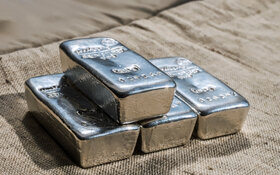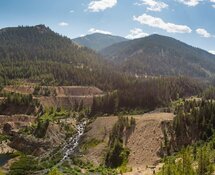The Gold Report:
Adrian, you are a long-term, value investor. That makes company selection critical. How do you evaluate what companies would fit your needs?Adrian Day: We manage money in all areas, not just gold and resources. I try to find good quality companies, buy them when they're selling for less than their value and hold on to them for a long time. I tend to be a very patient holder so long as the company itself doesn't change course or make disastrous decisions. I'm much less concerned about the outside environment so long as the company is doing what it said it was doing and continuing to grow, or earn cash flow. We have some very, very long-term holdings. In fact I just sold HSBC Holdings Plc (HSBA:LSE), which was the first stock we bought in 1991. That is an extraordinarily long holding period.
TGR: What made you decide to sell?
AD: I have been concerned about HSBC for a little while. I think the culture has changed. It made some disastrous mistakes in the U.S. sub-prime market. The potential criminal investigations in the U.S. on money laundering and in the UK on mis-selling mortgages made me think that maybe it was just time to get out. And the overall environment, frankly, for banking stocks is not positive. So we decided to move out.
We apply the same philosophy to gold and gold stocks. I'm not a geologist; I can't look at a particular property and say, "Wow, that's a great property about to be drilled; let's buy it." I tend to buy companies that have good business plans, good management and good balance sheets, which I think can grow over time.
TGR: Brian, you describe yourself as more of a prudent speculator. How do you pick companies?
Brian Ostroff: Unlike Adrian, we are not generalists. We operate two funds. One is natural resources as a whole and one is specific to mining. Where our funds really differ is that most of our partners are technical. They are geologists, mining engineers, metallurgists and the like. That allows us to look at situations a lot earlier than more traditional investors. I have always said that if we are going to take a big position in a select company, we need to understand why it has the potential to be a tenbagger. We also like lesser-known or lesser-appreciated commodities. That allows us to be the first movers in a particular commodity, hopefully in the best companies in the space because we can do our homework before the rest of the investing public starts to turn on to the theme and we enjoy the quick lift.
TGR: When we last interviewed each of you, you were both pretty optimistic—or at least not negative—about the timing for buying select junior companies. After all the volatility of late are you still feeling that way?
BO: I'm still very positively inclined toward some of the juniors. The key to the juniors is that we need to see the seniors perform better. We got really bullish in the summer about the seniors, which is not usually our space, except as a catalyst for money to come back to the juniors. The seniors had a wonderful lift of 20–30% off of their lows. A lot of that came from generalist funds as opposed to resource-specific funds. Unfortunately, what happened about three weeks ago was that just about every one of these major companies missed their numbers by a wide margin. A lot of the gains that came about from the summer have evaporated and I think a lot of the generalists' funds have exited the sector. That has probably pushed back the timeline for some of these juniors to wake up.
"I tend to buy companies that have good business plans, good management and good balance sheets, which I think can grow over time."
--Adrian Day
One thing, however, that is very encouraging is seeing some of the M&A activity, not so much the seniors buying the juniors, but mid caps buying into the juniors. I think that this will ultimately prove out the thesis that there is value in select juniors.
TGR: Is that one of the things you look for when evaluating whether the company could be a tenbagger or whether it is an acquisition target?
BO: Certainly, we try to understand what the drivers could be when we make an investment. One of our larger holdings, d'Arianne Resources Inc. (DAN:TSX.V; DRRSF:OTCBB; JE9N:FSE), which is actually a phosphate play, is an example of a company we believe could be taken out.
One of our largest holdings in the gold exploration space, Adventure Gold Inc. (AGE:TSX.V), is held for other reasons. Although the company could be acquired, for us it's more a matter of the parts being worth a lot more than the whole. The company has done a very good job cutting some deals on some assets while focusing on other assets that have been cheaper to move forward, thereby getting a lot of value from a little bit of money in the ground.
TGR: Adrian, in addition to juniors, you look at producers and royalty companies as well. What are you most excited about right now?
AD: Like Brian, I'm overall positively inclined to the sector, but Brian mentioned a very important word: "selective." It is so critical to be selective right now, particularly in the junior space as so many simply don't have enough money to last. Canadian companies can always raise the money. The question is on what terms. That is not good for the sector if they are issuing highly diluted shares. It increases the supply of stock without increasing the demand.
"If we are going to take a big position in a select company, we need to understand why it has the potential to be a tenbagger."
--Brian Ostroff
The senior gold stocks have been selling at pretty much the lowest valuations on many metrics, ever. In June, the Philadelphia Gold and Silver Index (XAU) was cheaper on cash flow, earnings, book value and dividend than the S&P. I don't remember the last time that happened. Even after the recent rally, the senior producers are still selling pretty much at their low point relative to bullion. In June and July, we loaded up on seniors, including Barrick Gold Corp. (ABX:TSX; ABX:NYSE) and Newmont Mining Corp. (NEM:NYSE), because they were just so ridiculously inexpensive. By the first week of October we sold virtually all the shares we bought. That is not my normal style, but it's difficult for me to be fundamentally positive on the senior producers as companies because they have let us down time after time. Barrick had an original cost estimate on Pascua Lama a little over $2 billion (B) and year after year it's gone up. Now it's at $8.5B. If you look at the senior mining companies on a 50-year basis, they have a negative return on equity. They are horrible companies. I see selected juniors as long-term core holdings.
I am also a big fan of royalty companies. The business model obviates a lot of the negatives in mining. And let's be honest, mining is a very difficult business. They say Murphy works overtime; things can and do go wrong. But royalty companies tend to obviate all of that because for the royalty company, the first dollar in is normally the last dollar in. In other words, when the royalty company decides a royalty is worth $200 million (M), it pays $200M. It may never get a penny out of that royalty, but that's the worst that can happen. It is not obligated to put more money up. It is not obligated to talk to the government to try to negotiate tax rates. And if tax rates go up, it doesn't really matter because most royalties are net smelter returns, on net profits. It is a return on what is produced and it doesn't matter if the tax rate goes up or the company has to move a village; it's all irrelevant to the royalty company. I like the royalty model a lot. Nobody would confuse royalty companies with Graham & Dodd value investments. Royalties are expensive. Franco-Nevada Corp. (FNV:TSX; FNV:NYSE) is now trading at about 45 times earnings. It is my favorite. It has $1.2B in cash on the balance sheet. It generates over $300M of free cash flow each year. Earnings should double in the next three years absent any new acquisition, and absent any increase in the price of gold. Earnings will double in three years just from the new royalties coming onstream. So I'm a big fan of the royalties as core holdings.
TGR: How does the current political environment, including the pending fiscal cliff, impact your positive view?
AD: I think the results of the election were positive for gold. Obama's reelection removed the threat that Federal Reserve Chairman Ben Bernanke would be leaving anytime soon and the monetary policy would change. That's a terrible thing for the economy, but it's very positive for gold.
We also have the same make up of Congress that we had before the election and six weeks to come up with a comprehensive solution to the U.S. deficit. One would like to think the politicians have learned their lesson. But they are just going to put it off for another few months so they can study it more. I do think the headlines won't be so outrageous because politicians remember what happened in 2011 when we had those last minute negotiations over the debt ceiling and the gold price went up dramatically.
TGR: Because the dollar crashed?
BO: Actually, the dollar did not crash. You know it's one of those ironies because what happened was that as a result of the U.S. losing its top-tier credit rating, everyone freaked out and in a rush for safety went out and they bought the U.S. long bond. In order to buy the U.S. long bond, they had to buy dollars. But gold did go up at the same time. Many believe gold acts inversely to the U.S. dollar. But that's not really the case. Gold is a currency and, in a free market, currency buyers have a choice: they can buy dollars, euro, yen, sterling or gold. They are not inversely related; preferences just shift. I think that it's possible to be bullish on both gold and the U.S. dollar.
"The beautiful thing about contrarian bets is you can put in a little bit of money and get a pretty big payoff."
--Brian Ostroff
What I worry about is that the fiscal cliff will probably, as Adrian says, get pushed down the road. People need clarity. Even if you don't necessarily like the solution, companies can at least know what the playing field looks like and start to do what they have to do. That will solve the money problem. There is more than enough money out there; what is important is the velocity of money. Trillions of dollars are sitting on corporate balance sheets. That money is not going anywhere until people figure out the ground rules.
AD: One thing we do know with some certainty is that investment taxes are likely to go up. After the election, people started selling stocks that paid high dividends and had long-term capital gains along with oil companies that probably won't do well under a Democratic administration.
BO: As a Canadian, I'm amazed at how ugly and polarized politics in America are. People are going to have to learn to get along with each other.
TGR: Are people getting along better in Europe and are there any signs from Europe you are looking for that could support or hurt gold prices or gold equities in 2013?
BO: That backdrop is actually very bullish for gold. Gold prices should continue to appreciate if only due to scarcity. I don't know how the euro ultimately ends, if it ends, if you have a Northern euro and a Southern euro, but people don't like uncertainty and the Euro is a very uncertain currency. That is bullish for gold. Maybe the answer is gold-linked debt. Let the investor choose between Spanish paper bonds at 5.50% or a bond at 0.50% backed by gold and interest paid in gold.
Europe's problems are not a huge drag on the U.S. economy because those countries are not big trading partners, but it is negative for China because it is reliant upon European consumers to buy products.
TGR: Adrian, you talked earlier about companies having to dilute their stock in order to get money. Are juniors going to have any better of a time in 2013 getting capital for projects?
AD: A lot of companies will come to market in 2013. In the last couple of weeks, a half dozen companies that didn't actually need the money went to market for funding, which is smart. If you don't need the money, you can demand better terms than when you are desperate. But a lot of companies are very, very low on cash.
BO: Things are a lot worse for the juniors today than they were in 2008. In 2008, most of these stocks lost 90% but they didn't stay down long and the window opened up for financing pretty quickly. Today, these stocks are down 70% (on average) but the window for financing has by and large been shut for 18 months and doesn't look too encouraging for the immediate future.
AD: And many of them had raised money in 2007, so there weren't that many companies that were desperate.
BO: Right. A lot of these companies are hard up for funding right now. More advanced companies with an asset are getting creative. We just provided a credit facility for one of our portfolio companies, d'Arianne. We like the asset. We believed that the share price didn't reflect the value of the company and didn't want to see the company issue more stock. This should take the company through a couple more milestones at which point we think they'll be in a better position to raise money. You will see more creative debt deals like that.
AD: Another type of deal we are seeing more of is royalty companies that for relatively little money at the pre-development stage, get a royalty on future production. That gives the company the financing it needs when it needs it. We are seeing more and more of that.
BO: The reality is that there is a limited capital pool for juniors. And it's a shame when some of these companies that are really not deserving get money because that leaves less capital for companies that are deserving. It would be very cathartic if a lot of these companies went away, leaving capital for the ones that have a legitimate chance of success.
TGR: So how do you determine which ones are deserving?
BO: It really takes four pieces: the rocks, management, financing and good investor relations. If you do not have all four of those, you are not going to tenbag. Sadly, some companies have just the investor relations piece and they get the money.
TGR: Based on all of the factors we have discussed, how are you adjusting your portfolio? What are you doing for 2013 to be better positioned?
BO: As I mentioned, we focus on lesser-known commodities. Our largest holding, the phosphate company d'Arianne, plays on the theme of security of supply. No one really understands the dynamics of the phosphate market. It is one of the three components for fertilizer—potash and nitrogen being the others—and the only one that North America is not self sufficient in. I can probably do without my iPad if there is a problem with getting the rare earths, but I'm probably not going to be able to do without eating. Morocco is the prime player in phosphate. Other players were Tunisia, Egypt, Syria and those stories didn't end particularly well. To be fully vertically integrated, North Americans have to mine their own phosphate rock. d'Arianne has a world-class deposit in Quebec and makes a very pure form of the concentrate. It has put out a prefeasibility study that shows a $1B net present value (NPV). If you were to plug in the price of the type of phosphate that it produces, you are closer to a $3B NPV. It has top-notch management and a sub-$100M market cap. We got in lower, but even from this level I think that you could get a multifold move. With the money it has now, it shouldn't have to raise money through the end of 2013. That takes the company through a full bankable feasibility study and quite a ways through permitting.
The real kicker is the possibility of an acquisition and the math on this is simple. To us, anyone who is not fully vertically integrated and has a decent balance sheet is a logical buyer. For example, Agrium Inc.'s (AGU:NYSE; AGU:TSX) Kapuskasing mine is closing within the next six to nine months due to depletion, which will add to the company's deficit by 1 million tons a year. The Mosaic Co. (MOS:NYSE) has publicly said it is looking to buy phosphate rock property because it is reliant on imports to make up its shortfall. Third party producers (such as the Moroccans) charge roughly $200/ton while d'Arianne will produce at roughly $90/ton. At 3 million tons a year and a $110/ton savings, this would result in $330M margin growth if one owned d'Arianne. That is real money and that is not even considering the security of supply issue. Even if one of those companies bought d'Arianne for $350M, which would be about $4/share, and put $700M into production, which for those companies wouldn't be a problem, it has a three year payback with 20, 30, 40 years of production and no worries that one day you are going to wake up and those pictures you see on TV are not Benghazi, but Rabat or Casablanca.
TGR: What other lesser-known sectors are you shifting to?
BO: Although it doesn't qualify as a lesser-known commodity, gold certainly qualifies as a lesser-appreciated commodity and that is amazing to me. People are talking about how poor gold is acting at $1,720/ounce (oz). We are $200/oz off of our all-time high and everyone hates gold. So I think that if we can click through $1,800/oz we will get a pretty good run.
Our favorite name there is Adventure Gold. That is one where the parts are worth a lot more than the whole. The company only has a $20M market cap. In the next week or two it will put out its initial resource calculation on its flagship property, the Pascalis. I think that is going to show that just that one property is probably worth two to three times the company's entire market cap. In addition, the company does a very good job of assessing properties. It has done deals with Lake Shore Gold Corp. (LSG:TSX) and Agnico-Eagle Mines Ltd. (AEM:TSX; AEM:NYSE) to move forward projects that would be expensive to do on its own. Adventure Gold also has a great portfolio of properties including a land package up in Detour just to the eastern side of Detour Gold Corp. (DGC:TSX). It is intertwined with Balmoral Resources Ltd. (BAR:TSX.V; BAMLF:OTCQX), which has done very well. It is probably the best property finder we have come across and has top class management. At some point it will get some attention, which should result in a considerably higher stock price.
TGR: What is your distribution of physical gold vs. junior and producer?
BO: We really don't own any physical. We have some iShares Silver Trust (ETF SLV:NYSE), which is the silver exchange-traded fund (ETF), but our focus really is in the juniors.
TGR: Adrian, how are you adjusting your portfolio?
AD: We own about 10—11% physical gold and ETFs and we are increasing our holdings of physical gold, which to us is a sort of bedrock of the portfolio. Over the last several years, we have moved away from the senior producers toward exploration companies. We are about 27% in seniors right now and that includes the royalty companies. In fact half of our seniors are royalty companies. Most of our money is in exploration companies. But, again, I am not a geologist so I tend to look at companies that have a business plan that I like that enables the company to stay around. One of the big problems in this business is that when things go wrong you don't get just a 10% or 20% haircut; you get 70%, 80%, 90% price declines. One of the keys to being successful is to try as much as possible to avoid huge declines.
One company we like a lot is Virginia Mines Inc. (VGQ:TSX). It started as a prospect generator, but it has gone way beyond that now. It has about 27 different projects. About 11 of those projects are active with joint venture partners. But it also is doing a lot of work itself now. It has a strong balance sheet, over $40M in cash and it gets money from its joint venture partners for managing the projects. The cash balance tends to increase year over year even though it is not actually producing anything yet. It also enjoys a royalty on the Éléonore deposit it sold to Goldcorp Inc. (G:TSX; GG:NYSE). After the second full year of production, if gold stays above $1,500/oz, Virginia will earn $30–35M a year in free cash flow for 17 years. The company's market cap is only around $300M. A net present value on the future cash flow will show that the royalty is actually worth more than the market cap of the entire company. That royalty could be sold tomorrow in a heartbeat. It means the company never has to raise money again if it doesn't want to. It also has a nickel deposit ready to sell to somebody when prices get better. The gold resources, joint ventures, exploration, everything else is free. I like that one a lot and continue to like it. It's about $9.80/share right now so it has gone up quite a bit, but is still cheap compared to the value. And of course the closer we get to the last quarter of 2014, when Goldcorp commences production at Éléonore, the more valuable that royalty becomes. The discounted value of the future cash flow gets higher as it gets closer to actually earning the money. So it is logical that this stock is moving up.
We also like stocks that look as though they have the potential to be really big in the long run. I think back to Diamond Fields Resources Inc. in Voisey's Bay in Newfoundland. We were buying all the way up. We were buying at $2, at $4, and $8/share. We were even buying at $30/share because the higher the stock price went, the closer to the actual deal the asset was worth. At $30/share it was probably a better buy than it was at $2/share, frankly, on a risk-reward basis. One that we view similarly, even if it doesn't have the exact same performance, is Reservoir Minerals Inc. (RMC:TSX.V), which has a spectacular copper discovery in Serbia. Freeport-McMoRan Copper & Gold Inc. (FCX:NYSE) is a joint venture partner. Freeport's doing all the work and has released the assays from two absolutely spectacular drill holes. One of the geologists said to me that he had never seen a drill hole that looked better in his life.
TGR: One last prediction for 2013?
BO: I'm going to go with a contrarian view. I wouldn't put 100% of my money on this bet, but the beautiful thing about contrarian bets is you can put in a little bit of money and get a pretty big payoff. Everyone is having the discussion about whether China will have a hard landing or soft landing. We are getting more comfortable with the thought of no landing. Therefore, we are in the process of looking at some very cheap assets because everyone thinks China is about to hit the wall. If China doesn't hit the wall, that's how you get a tenbagger. You probably get a three- or fourbagger just on the relief.
AD: I agree. I like to quote Mark Mobius: "I think China is still flying." We buy very few Chinese companies. We are concerned about the books and local government interference with businesses. One we have bought recently is Sino Agro Foods Inc. (SIAF:OTCBB), a dairy company. It trades on the OTC and it's extraordinarily cheap.
We are also buying some European companies outside the Eurozone, but frankly are not really considering the strength of the euro. We are looking at holding companies trading at big discounts, companies like Pargesa Holding S.A. (PARG:SW), a Swiss company that owns shares in Total S.A. and Suez S.A. and GDF Power, Imerys S.A. and Pernod, the spirits company. It has cash on the balance sheet, yields over 4%, is actually selling at a 28% discount to the value of the publicly traded shares it owns. That is a margin of safety. A similar situation is Investor AB Series B (SE:INVEB:STO), a Swedish company run by the Wallenberg family. It is a good, long-term value investor focused on Scandinavian companies and trading about a 25% discount to the value of the shares it owns. And again a pretty good margin of safety.
TGR: We will have to check back in on both of those next year to see if you are right. Thank you for taking the time to talk to me.
Adrian Day, London born and a graduate of the London School of Economics, heads the eponymous money management firm Adrian Day's Asset Management (adriandayassetmanagement.com; 410-224-2037), where he manages discretionary accounts in both global and resource areas. His latest book is "Investing in Resources: How to Profit from the Outsized Potential and Avoid the Risks."
Brian Ostroff is a managing director at Windermere Capital, where he focuses on the junior and mid-tier mining sectors. He brings over 25 years of small-cap mining expertise to the table, having served at RBC Dominion Securities and as a managing partner at Goodrich Capital, an M&A advisory firm. Prior to joining Windermere Capital in 2009, Ostroff spent four years as an independent proprietary trader.
Want to read more Gold Report interviews like this? Sign up for our free e-newsletter, and you'll learn when new articles have been published. To see a list of recent interviews with industry analysts and commentators, visit our Interviews page.
DISCLOSURE:
1) JT Long of The Gold Report conducted this interview. She personally and/or her family own shares of the following companies mentioned in this interview: None.
2) The following companies mentioned in the interview are sponsors of The Gold Report: Franco-Nevada Corp., Detour Gold Corp., Balmoral Resources Ltd. and Goldcorp Inc. Streetwise Reports does not accept stock in exchange for services. Interviews are edited for clarity.
3) Adrian Day: I personally and/or my family own shares of the following companies mentioned in this interview: Franco-Nevada Corp., Virginia Mines Inc., Reservoir Minerals Inc. and Pargesa Holdings S.A. Clients of my firm own all shares mentioned as recommendations, Barrick Gold Corp., Newmont Mining Corp., Franco-Nevada Corp., Virginia Mines Inc., Reservoir Minerals Inc., Sino Agro Foods Inc., Pargesa Holdings S.A. and Investor A/B. I personally and/or my family am paid by the following companies mentioned in this interview: None. I was not paid by Streetwise Reports for participating in this interview.
4) Brian Ostroff: I personally and/or my family own shares of the following companies mentioned in this interview: Adventure Gold Inc. and d'Arianne Resources Inc. I personally and/or my family am paid by the following companies mentioned in this interview: None. I was not paid by Streetwise Reports for participating in this interview.











































